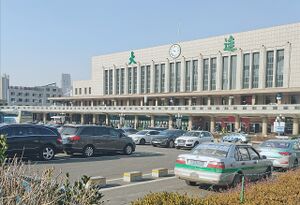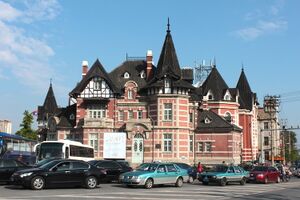Dalian
| Dalian | |||||
|---|---|---|---|---|---|
| Japanese Name | ターリェン | ||||
| Weapon | |||||
| Race | Beast | ||||
| Nationality | |||||
| Birthday | May 20 | ||||
| Constellation | Taurus | ||||
| Talents | Fights | ||||
| Likes | Weapons, Nishikese cursed objects and antiques | ||||
| Dislikes | People who are all talk and no action | ||||
| Strengths | Possesses a strong sense of duty and honor | ||||
| Weaknesses | Short-tempered | ||||
| Hobbies | Collecting antiques | ||||
Ah'm Dalian, chairman of Tianlaohui, an association that scares crying children into silence. We've always have a close relationship with the military guys, though I never expected myself to one day wear a military uniform like this... Ah, did I just said something by mistake? Sorry sorry. You should pretend that you didn't hear any of that. Muh regards to you, 'Sir'.
Layers
| Icon | Title | Release Date | Where to Obtain |
|---|---|---|---|
| [Tianlaohui Triad Leader] Dalian | 2024 January 8 | [Training Camp - Dalian] Event Reward | |
| [Understanding of Subordinates] Dalian | 2024 January 12 | [The Uncaught Racoon in Jiulong Castle] Event Reward | |
| [Small Yet Mighty Boss] Dalian | 2024 January 12 | [The Uncaught Racoon in Jiulong Castle] Pick Up Gacha, Premium Gacha |
Skills
Trivia
- Dalian's birthday is the completion date of Dalian station in 1937.
- Dalian's animal motif is the giant panda, China's national animal.
- Dalian's triad name, Tianlaohui, is a reference to Tiandihui, although her thematic is based off mostly Chinese triads and Russian mafia that is famous in Dalian, China.
- Her gang motif is from China's underground 'black society' (黑社会), and the Chinese triads within, comparable to the Italian mafioso, the Russian mafia and the Japanese yakuza. Her quote about 'having close connections to the Eisengrad Army' directly references the belief that Chinese triads in modern times have long been alleged to have connections to the government of the People's Republic of China.
- Her strengths of duty and honor, and her weapon of choice, a guandao, is a reference to Guan Yu, a Chinese military general serving under the warlord Liu Bei during the late Eastern Han dynasty of China, also known as the God of War, Honor and/or Wealth. Although seemingly ironic, members of the triads and Tiandihui worship Guan Yu as well. Statues used by triads tend to hold the halberd in the left hand, and statues in police stations tend to hold the halberd in the right hand. This signifies which side Guan Yu is worshipped, by the righteous people or vice versa. The appearance of Guan Yu's face for the triads is usually more stern and threatening than the usual statue.
- The building in the background of [Small Yet Mighty Boss] is the facade of Dalian railway station.
Counterpart
Dalian railway station (simplified Chinese: 大连站; traditional Chinese: 大連站; pinyin: Dàlián Zhàn) is a railway station of the Harbin–Dalian section of the Beijing–Harbin High-Speed Railway. It is located in Zhongshan District, Dalian, Liaoning, China. The station opened in 1903. Dalian Station is located in the Zhongshan District of Dalian, Liaoning Province, People's Republic of China, in the historic city centre business district of Qingniwa Bridge. The station was built in 1937 by Sotaro Ota, the designer of the then Manchurian Railway, modelled on Ueno Station in Tokyo, and was expanded in 2002 with the construction of an elevated station building, an additional north exit and a plaza in the northern part of the station. It is now a Category One station under the jurisdiction of Shenyang Railway Bureau, and is also the departure station of Shenyang-Dalian Railway, handling about 80 passenger trains per day.
The 1898 Treaty of Lushun between the Qing and the Russians stipulated that China would allow Russia to build a railway from a station on the East Qing Railway (later designated as Harbin) to Lushun via Changchun and Shenyang, and construction began in June of that year. Dalian Station was built in July 1903, originally named Dalniy Station, as a station on the southern branch of the China-Changsha Railway, near the present Victory Bridge. The station building was only a wooden hut. After the Russo-Japanese War, Japan acquired the Liaodong Peninsula and set up the South Manchurian Railway Co. In 1907, the Manchurian Railway moved its headquarters from Japan to Dalian, and took over the former China-Changsha Railway and renamed the station Dalian Station.
With the expansion of the city of Dalian and the increase in throughput of Dalian port, the Manchurian Railway planned to expand Dalian station in 1924, and the proposal of Sotaro Ota and Ryoji Kobayashi was selected. However, construction of the new station building did not begin until 1935 and was completed on 20 May 1937, making it the largest railway station in Asia at the time. By 1995, Dalian Station had an area of 8,433 square metres. In 2000, the expansion project for Dalian station started with a new elevated waiting hall and the addition of the north exit and the station's north plaza, completed by 1 August 2003. In 2008, at the unified request of the railway department, Dalian station completed the south ticket hall from the first floor to the ground floor to separate the ticket hall and the waiting room.
In order to meet the requirements of the Hexie trains, the station underwent an internal renovation on 1 April 2010, with 1,250 mm high platforms and new canopies without platform pillars. The station was also renovated to a new floor with a new ticket hall. During the renovation period, some trains were adjusted to depart from Zhoushuizi and Jinzhou stations, and reverted on 11 January 2011 when the renovations were completed, and on 30 December 2012, some of the trains that originally started and ended at Dalian North Station were extended to Dalian Station. Wikipedia
Dalian /ˌdɑːˈljɛn/ is a major sub-provincial port city in Liaoning province, People's Republic of China, and is Liaoning's second largest city (after the provincial capital Shenyang) and the third-most populous city of Northeast China (after Shenyang and Harbin). Located on the southern tip of the Liaodong peninsula, it is the southernmost city in both Liaoning and the entire Northeast. Dalian borders the prefectural cities of Yingkou and Anshan to the north and Dandong to the northeast, and also shares maritime boundaries with Qinhuangdao and Huludao across the Liaodong Bay to west and northwest, Yantai and Weihai on the Shandong peninsula across the Bohai Strait to the south, and North Korea across the Korea Bay to the east.
In the 1880s, Jinzhou, the north of downtown Dalian, now Jinzhou District, was a walled town and a center for political intrigue and economic activity. The British briefly occupied Qingniwa during the Second Opium War in 1858, but returned it to Chinese (Qing) control in 1860. Port Arthur at the tip of the Liaodong Peninsula took its English name from Royal Navy Lieutenant William Arthur, though the area's Chinese name had always been Lüshun. In the First Sino-Japanese War, Japan committed the Port Arthur massacre on 21 November 1894 in the Battle of Lüshunkou. In April 1895 China conceded defeat in the First Sino-Japanese War, ceding Liaodong Peninsula, Taiwan and Penghu, and making many other concessions in the Treaty of Shimonoseki (17 April 1895). In the Triple Intervention of 23 April 1895, Russia, France and Germany forced Japan to return the Liaodong Peninsula to China, despite the treaty's terms. The Russians built a modern commercial port city, which they wanted to become the Paris of the Far East, and called it Dal'niy (Russian: Дальний). Linked by 1902 with the Trans-Siberian Railway via the branch line Chinese Eastern Railway through Harbin, Dal'niy became Russia's primary port-city in Asia while also serving Western traders. Russia signed the Pavlov Agreement (1898) with China, which granted Russia a 25-year lease on Dalian and Lüshun and exclusive right to build a branch of the Chinese Eastern Railway.
During the Russo-Japanese War of 1904-1905, the Liaodong Peninsula became a major battleground. Major-General Baron Anatoly Stoessel defended a besieged Port Arthur, for five months (August 1904 to January 1905), but the Japanese army, using long-distance fire, sank several Russian ships at the Port Arthur naval base in early December 1904. After the Imperial Japanese Navy crippled the remaining Russian battleship Sevastopol in three weeks of constant attacks, and explosives detonated in tunnels destroyed Port Arthur's remaining defenses in the final days of 1904, Russia negotiated a ceasefire and surrendered Port Arthur in January 1905. With the unconditional surrender of Japan in August–September 1945, Dairen passed to the Soviets, whose Manchurian Strategic Offensive Operation had liberated the city on 22 August 1945. The Soviets and Chinese Communists cooperated to develop the city, relatively undamaged during the war, especially its industrial infrastructure and the port. In 1950 the USSR presented the city to the Chinese Communist government without any compensation. Dalian and Lüshun (former Port Arthur) merged as Lüda on 1 December 1950. In 1981 the city was renamed Dalian, with Lüshunkou becoming a constituent district. In 1984 the Chinese Government designated the city a Special Economic Zone. At the time, Dalian was China's largest foreign-trade port. Wikipedia
Map
Gallery
- Pages using Tabber parser tag
- Pages using DynamicPageList3 parser tag
- Weapon Spear
- Beast
- Eisengrad
- Taurus
- Element Pierce
- Element Fire
- Element Dark
- Train Knights
- China














